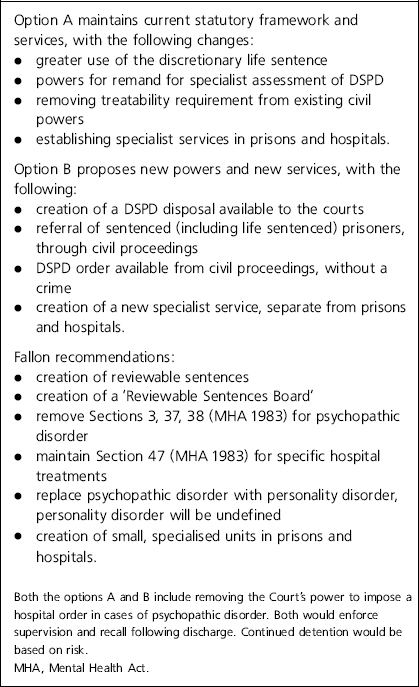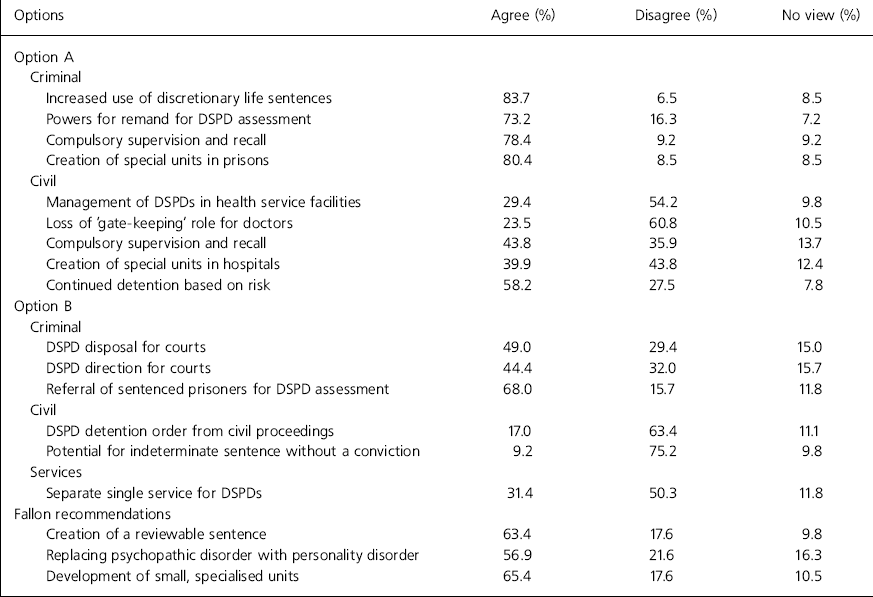Personality disorder has long been a source of debate, with diagnosis and treatability being particularly controversial (Reference CopeCope, 1993). The Home Secretary has criticised psychiatrists for not detaining untreatable individuals. The Fallon Inquiry into Ashworth Hospital's personality disorder unit (1999) recommended the creation of reviewable sentences for high-risk individuals. It did not consider unconvicted but dangerous individuals.
In July 1999 a Government consultation paper (Home Office & Department of Health, 1999) introduced proposals for the minority of people with severe personality disorder who, because of their disorder, pose a risk of serious offending. Dangerous severe personality disorder (DSPD) was not defined in the document, but two options were proposed (see Box 1).
Box 1 The recent proposals relating to dangerous people with severe personality disorder (DSPD)

| Option A maintains current statutory framework and services, with the following changes: |
|
| Option B proposes new powers and new services, with the following: |
|
| Fallon recommendations: |
|
| Both the options A and B include removing the Court's power to impose a hospital order in cases of psychopathic disorder. Both would enforce supervision and recall following discharge. Continued detention would be based on risk. |
| MHA, Mental Health Act. |
Method
Meetings were held in four centres (Ashworth, Broadmoor and Rampton Hospitals and The Bracton Clinic Medium Secure Unit). Consultants and senior trainees working in forensic settings were invited to attend. Following a presentation of the Government proposals, psychiatrists discussed key issues and completed a questionnaire. The content of discussions was recorded and key themes extracted. Data were analysed using SPSS for Windows (Norussis/SPSS Inc.).
Results
Respondents
A total of 153 questionnaires were completed, 60% (n=91) from consultants (67.9% of the consultant membership of the Forensic Faculty of the College) and 26.8% (n=41) from senior trainees (45.5% of the senior trainee membership). The responses were split between those working in maximum (special hospitals) and medium security, 40.5% (n=62) and 51.6% (n=79), respectively, and 7.9% (n=5) worked in other services.
Definition/assessment issues
Sixty-eight per cent (n=104) of psychiatrists felt confident in their ability to diagnose personality disorder, but only 34.6% (n=53) felt severe personality disorder was identifiably different. Seventy-one per cent (n=109) were not confident in the interrater reliability of personality disorder diagnosis. Of the 109 respondents who attempted to define DSPD, 48 (44%) included ICD—10 (World Health Organization, 1992) or DSM—IV (American Psychiatric Association, 1994) definitions of personality disorder, 21 (19%) felt it was not systematically definable. Severity was defined in a variety of ways, including: risk of offending (n=28; 26%); effect on functioning (n=23; 21%); number of traits of specific personality disorder diagnoses (n=13; 12%); the number of personality disorder diagnoses (n=12; 11%); lack of response to treatment (n=10; 9%); and level of emotional instability (n=6; 6.5%).
The majority (125, 82%) reported that available risk assessment procedures are inadequate to reliably identify potentially dangerous individuals, and 70% (n=107) admitted that the Government proposals would make them more cautious about making a diagnosis of personality disorder. Many psychiatrists questioned the validity of the Government's estimate of the numbers involved, given the lack of clarity.
A total of 22.2% (n=34) felt that doctors should be involved in the assessment of personality disorder and 93% (n=142) saw a medical role in assessing for intercurrent mental illness. One-hundred (65.4%) reported that psychiatrists should be involved in risk assessments on DSPDs, but five respondents (3.3%) felt psychiatry has no role. Overall, 18.3% (n=28) believed psychiatrists should take a lead role in these services, 31% (n=47) thought that psychologists should be the team leaders.
Treatability
Eighty-three (54%) considered personality disorder in general as being a treatable condition. Psychiatrists working in the South of England and in Wales were significantly more likely than those in the North to hold this view (66% v. 47%, χ2=4.975, d.f.=1, P=0.026). Special hospital psychiatrists were also significantly more likely to consider personality disorder treatable (66% v. 46%, χ2=5.928, d.f.=1, P=0.015). Considering those with severe personality disorder, only 28% (n=43) reported that this group are treatable. Special hospital psychiatrists were again significantly more likely to view severe personality disorder as treatable (37% v. 22%, χ2=4.172, d.f.=1, P=0.041). Many commented on the lack of evidence that there are effective treatments for those at the extreme end of the spectrum.
Nearly two-thirds (62.7%, n=96) objected to the removal of the ‘treatability criteria’ from civil powers to detain DSPDs. Those viewing personality disorder as treatable were significantly more likely to accept this (37% v. 13%, χ2=11.797, d.f.=1, P=0.001).
Services for those with DSPD
Most respondents (45.1%, n=69) believed that services for those with DSPD should be the joint responsibility of the Home Office and the Department of Health. Half (50.3%, n=77) of the sample believed the key emphasis of services should be treatment, but 27.5% (n=42) felt public protection should be the main focus. The majority (78.4%, n=120) believed that DSPDs should be managed in units that are separate from the units for those with mental illness. Fifty per cent (n=77) felt that current facilities are satisfactory if given sufficient resources.
The vast majority (88%, n=134) did not concur with the Government's suggestion that the new units could be staffed by the current workforce and only 21% (n=32) reported a willingness to work in DSPD units. However, 58.2% (n=89) stated that they would undertake assessments of diagnosis and risk in DSPDs. Those who believed personality disorders were treatable were significantly more likely to show a willingness to work in the new services for DSPDs (34% v. 6%, χ2=18.026, d.f.=1, P=0.000).
The proposals
Overall, there was no consistent view as to which option is preferable. Eighteen per cent (n=28) supported Option A, 21% (n=32) Option B and 28% the Fallon recommendations (see Box 1 and Table 1), but 13% expressed a preference for ‘no change’ in the current position.
Table 1. Elements of the proposals not covered elsewhere

| Options | Agree (%) | Disagree (%) | No view (%) |
|---|---|---|---|
| Option A | |||
| Criminal | |||
| Increased use of discretionary life sentences | 83.7 | 6.5 | 8.5 |
| Powers for remand for DSPD assessment | 73.2 | 16.3 | 7.2 |
| Compulsory supervision and recall | 78.4 | 9.2 | 9.2 |
| Creation of special units in prisons | 80.4 | 8.5 | 8.5 |
| Civil | |||
| Management of DSPDs in health service facilities | 29.4 | 54.2 | 9.8 |
| Loss of ‘gate-keeping’ role for doctors | 23.5 | 60.8 | 10.5 |
| Compulsory supervision and recall | 43.8 | 35.9 | 13.7 |
| Creation of special units in hospitals | 39.9 | 43.8 | 12.4 |
| Continued detention based on risk | 58.2 | 27.5 | 7.8 |
| Option B | |||
| Criminal | |||
| DSPD disposal for courts | 49.0 | 29.4 | 15.0 |
| DSPD direction for courts | 44.4 | 32.0 | 15.7 |
| Referral of sentenced prisoners for DSPD assessment | 68.0 | 15.7 | 11.8 |
| Civil | |||
| DSPD detention order from civil proceedings | 17.0 | 63.4 | 11.1 |
| Potential for indeterminate sentence without a conviction | 9.2 | 75.2 | 9.8 |
| Services | |||
| Separate single service for DSPDs | 31.4 | 50.3 | 11.8 |
| Fallon recommendations | |||
| Creation of a reviewable sentence | 63.4 | 17.6 | 9.8 |
| Replacing psychopathic disorder with personality disorder | 56.9 | 21.6 | 16.3 |
| Development of small, specialised units | 65.4 | 17.6 | 10.5 |
There was greatest disagreement over the proposed changes in civil legislation (Table 1). The notion that unconvicted DSPDs could be detained solely on the basis of public protection, rather than individual mental health, caused particular disquiet with some drawing parallels with the role of psychiatrists as agents of social control in the former USSR. Several commentators also suggested that the Government was ‘medicalising’ DSPD to achieve this.
For DSPDs involved in criminal proceeding, psychiatrists agree with the suggestion that there should be increased use of discretionary life sentences as suggested in Option A. Many commented that the necessary legislation to detain convicted individuals with DSPD already exists in criminal justice legislation, but that judges have been reluctant to utilise it. Furthermore, many pointed out that indeterminate medical detention without effective treatment might be in direct conflict with the General Medical Council (GMC) guidelines (1998) stated in Duties of a Doctor.
Discussion
The Government proposals on DSPD, which clearly focus on public protection, address some of the problems and limitations within current legislation, but emphasise the role of psychiatrists rather than other agencies. As yet, there has been little commentary apart from Eastman (Reference Eastman1999) and Mullen (Reference Mullen1999) highlighting legal and ethical concerns.
This survey illustrates the continuing concern over the lack of clarity in the term DSPD. Most psychiatrists are aware of the low level of agreement over personality disorder diagnoses, even using structured interview schedules. Furthermore, they are uncomfortable with the concepts of severity and dangerousness. While the North American literature on violence risk prediction suggests that instruments such as the Psychopathy Checklist—Revised (PCL—R; Reference HareHare, 1991) and Historical, Clinical, Risk Management (HCR—20; Reference Webster, Douglas and EavesWebster et al, 1995) are useful, they are not fail safe (Reference Douglas, Cox and WebsterDouglas et al, 1999). Our study shows that psychiatrists advise caution when diagnosing severe personality disorder.
There is the further issue that DSPD is ill-defined, meaning the figures cited in the Government document may be inaccurate. The numbers detained will undoubtedly grow as admissions outpace discharges given the emphasis on public protection.
Many felt that any doctor involved in the detention of these individuals for public protection alone would potentially breach the GMC's guidelines (1998) that state “make the care of your patient your first concern”, and that doctors are abusing their professional position if they “give patients, or recommend to them, an investigation or treatment which you know is not in their best interests”. Advice from the GMC may be welcome at this time.
The majority of respondents believed that sentencing and detention should fall within the remit of the courts and that psychiatrists should restrict themselves to assessments of suitability for specific interventions. There is clearly and rightly more reservation over the contribution of psychiatry in those with a primary diagnosis of antisocial personality disorder. This is based on extensive literature that suggests that antisocial personality disorder with high PCL—R scores (Reference HareHare, 1991) does appear to benefit from current therapeutic strategies (Losel, 1998). Although there is evidence that some individuals with personality disorder can benefit from treatment in therapeutic communities it must be recognised that these programmes generally only take on those who are willing and likely to benefit from the treatments available.
The low numbers of psychiatrists willing to work in DSPD services seems likely to create significant recruitment problems. Furthermore, these units may become isolated and standards could be hard to maintain. The survey findings, however, do suggest that a substantial number are willing to assess individuals for these units. A split between those assessing and those treating personality disorder may cause problems. The concept of preventative detention in health care settings of those who had not been convicted and are untreatable is considered unethical practice (Reference MullenMullen, 1999).
The role of psychiatry in the assessment and treatment of personality disorders has always been controversial (Reference CollinsCollins, 1991; Reference CopeCope, 1993; Reference MoranMoran, 1999) and this is likely to continue in the absence of a sound research base.





eLetters
No eLetters have been published for this article.